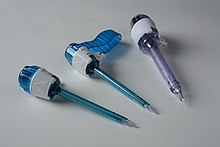Trocar
The trocar is an instrument with the help of which in minimally invasive surgery a sharp or blunt access to a body cavity (e.g. abdominal cavity, chest cavity) is created and held open by a tube (= tube). It is a pin that is inserted in a tube with an inner diameter of z. B. 0.5-12 mm, and the tip closes the opening of the tube. Tube and trocar are z. B. introduced through the abdominal wall into the abdomen. The surgeon has then withdrawing the trocar from the tube the possibility of using an optical system ( endoscope to view) through the tube into the abdominal cavity, or gripping, cutting and other instruments within the abdominal cavity in a minimally invasive to operate.
Modern trocars are either made of titanium , surgical steel or plastic and are manufactured as single or reusable instruments. The tips are adapted to the tubes and have sharp cutting edges for sharp preparation of the access route or a blunt, conical tip for blunt preparation. The tubes especially for the inspection of body or joint cavities ( laparoscopy , thoracoscopy , arthroscopy ) can have a valve mechanism , a connection for insufflating (blowing in) CO 2 or rinsing fluids or other additional equipment.
In veterinary medicine , trocars are also used to release gas accumulations ( flatulence ) in the rumen ( rumen sting ) or appendix .

